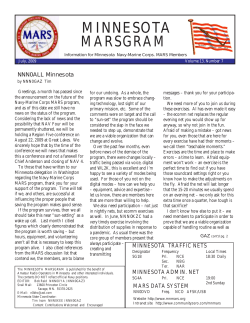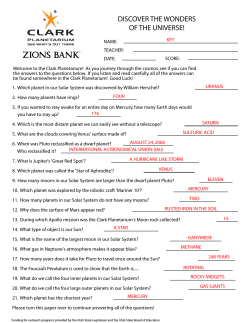
APPENDICIES Appendix Activity #1 Appendix Activity #2
APPENDICIES Appendix Activity #1 Make Scale Models of the Planets By making models of each planet at the same scale, students see how the planets compare in size. Appendix Activity #2 Make a Model Solar System In this activity, students learn about the organization and scale of the solar system. Students make a model of the solar system using the same scale they used for the planet models in Appendix Activity 1. When people see a solar system model in which both the sizes and distances of the planets from the Sun are at the same scale, they are usually surprised by how small and far apart the planets are! Appendix Activity #3 Find Mars in the Night-time Sky When ancient astronomers noticed that Mars moved slightly from one night to the next, they considered it a special “star.” If the timing is right, your students will be able to see Mars in the night-time sky. If they observe it over a few weeks, they too will notice that it moves. This activity enables your students to know where and when to look for Mars. 75 APPENDIX ACTIVITY 1: MAKE SCALE MODELS OF THE PLANETS THE PLANETS & THEIR REALITIVE SIZES Mercury Venus Earth Mars Jupiter For a long time, people thought that the Earth was the center of the Universe, with the Sun, Moon, stars and planets circling around the Earth. This idea made complete sense based on what people saw when they looked up at the sky. Today we know that the Earth is not the center of everything. The Universe is incredibly huge, with many more stars than we can see at night. Our Sun is just one of those stars, although it certainly is the most important one for us. Earth and Mars are both planets which go around the Sun. There are a total of nine planets in our Solar System. Though all nine planets are the same shape — roughly spherical — they vary considerably in their sizes. Looking at them in the sky is no real help in comprehending their sizes because, at great distances, even the giant planets appear as dots. In this activity, you will make models of the planets, in order to compare their sizes. Saturn Uranus Neptune Pluto Activity 1: Make Scale Models of the Planets Activity 5: Creating Appendix a Large-Scaled Model of Catastrophic Flooding 76 How Do the Planets Compare in Size? Materials: paper, scissors, pen or pencil, drawing compass, ruler At the right is a table called “Sizes of the Planets.” For each planet, it shows the actual diameter in kilometers. It also shows how to create scale models that are one billion times smaller than the real planets. 1 To make two-dimensional paper models of each planet, find the “scaled diameter” column. Start with the Earth. Earth’s real diameter is 12,800 km. The “scaled diameter,” at one billionth reduction, is 1.3 cm (actually it is 1.28 cm, but it is rounded off to the nearest tenth of a centimeter). Use a compass to draw a circle that is 1.3 cm in diameter and cut it out with scissors. This circle represents Earth. 2 Repeat Step 1 with the other planets. For each planet, cut out a circle that is the “scaled diameter.” Label each planet with its name and diameter. (Mercury and Pluto will be too small to label). Sizes of the Planets Planet Actual Diameter Scaled Diameter 4,880 km Mercury 0.5 12,100 km Venus 1.2 12,800 km Earth 1.3 6,800 km Mars 0.7 142,000 km 14.2 Jupiter 120,000 km 12.0 Saturn 51,200 km Uranus 5.1 48,600 km Neptune 4.9 2,200 km Pluto 0.2 1,392,000 km 139.2 Sun Scaled diameter is 1 billionth of actual size 3 After you cut out all the planets, glue or tape them into your journal. One student in the class should set aside the paper planets and not glue them to his or her journal. You will need them for the next activity. 4 Finally, make a scale model of the Sun. Tape several pages of newspaper together and cut out a circle that is 139 centimeters in diameter. Label it “Sun.” 5 Discuss in class or write in your journal: • How do the planets compare in size? • Which planet is the largest? Smallest? • Which is most nearly the size of Earth? • Is Mars larger or smaller than Earth? • What surprised you most about this activity? Appendix Activity 1: Make Scale Models of the Planets 77 cm cm cm cm cm cm cm cm cm cm APPENDIX ACTIVITY 2: Make a Scale Model of the Solar System You have made a scale model showing the size of the planets. The next step is to make a model showing how far they are from the Sun. Make a Scale Model of the Planets in Orbit Materials: meter stick or metric tape measure 1 At this one-billionth scale, how far is the Earth from the Sun? Go outside with the scale models of the Sun and the planets. Find a large space such as a playing field. Put the Sun on the ground at one end of the field. Walk away from the Sun and stop where you think the Earth belongs at this scale. Appendix Activity 2: Make a Scale Model of the Solar System 78 2 Referring to the data table on the left of this page, look at the actual distance from the Sun to the Earth and the scaled distance. You will see that the Earth is 150 meters away from the Sun at this scale. Put the scaled Earth on the ground at this distance. Distances from the Sun Planet 3 4 5 6 7 Where would Mars be at this scale? Closer to the Sun? Farther away? Walk to the place where you think Mars belongs. Mercury Venus Earth Look again at the data table. Find the scaled distance from the Sun to Mars and measure off this distance. Put the paper cut-out Mars Jupiter of Mars there. Saturn Uranus Now use the data table to correctly position Mercury and Venus. Neptune Again put the paper cut-outs there. You have now completed Pluto what are called the inner planets. The outer planets are even farther away. In fact, they are so far away in this scale model that they will probably not fit on your school property. Try Jupiter. Actual Distance 58,000,000 108,000,000 150,000,000 228,000,000 778,000,000 1,424,000,000 2,867,000,000 4,488,000,000 5,910,000,000 Scaled Distance km km km km km km km km km 58 108 150 228 778 1,424 2,867 4,488 5,910 m m m m m m m m m Scaled distance is 1 billionth of actual distance Do the same for Saturn, Uranus, Neptune and Pluto. Use a map of the area around your school to mark where these planets would be. n te i i r w or : s ? s a cl urnal Sun n i e o s j th cus your to t s Dis se clo e h ? t Sun t is e e h n t pla ? r to ich thest e s h or clo r • W e far e h rm art Th wa rE s o i big y? rs rs w h a a o h M W kM ity, • Is v i hin Earth? t t ac you than he t o in • D lder this sed t u u co o le sca be? t ab s e o h m tt you ou • A ould y ed w pris r u s hat ty? W • ivi act Appendix Activity 2: Make a Scale Model of the Solar System 79 PART A APPENDIX ACTIVITY 3: Find Mars in the Night-Time Sky Ancient astronomers all over the world were fascinated by “stars” that changed their positions in the sky. The Greeks called them planets, which means “wanderer.” Mars is one of nine “wanderers.” Mars is a Wanderer in the Night-Time Sky Look at the two pictures on below. They are almost exactly alike. They show the position of several stars (and one planet) in the night time sky. The picture on the left is May 1, 1996; the one on the right is May 8, 1996, one week later. 1 Find a difference between the two pictures. 2 How might you explain this difference? May 1, 1996 May 8, 1996 Activity 5: Creating a Large-Scaled Model3:of Catastrophic Appendix Activity Find Mars in theFlooding Nighttime Sky 80 PART B Go outside at night and look at the stars. Of all those dots of light, which one is Mars? Or, can you even see Mars at all? Here is how to know where to look. Where Do I Look? To find out exactly where in the sky to look to see a planet, visit Solar System Live, a Web site that provides a planet’s coordinates for any time or day. Where Is Mars? http://www.fourmilab.ch/ solar/solar.html The Sun and Mars follow the same path across the sky Enter your “Time” and “Observing Site” information. Then, hit “Update.” The two numbers you need are: Altitude, the number of degrees above or below the horizon. Azimuth, the local compass bearing to the planet at your site. 1 2 Find the path of the Sun — Mars follows the same path in the sky as the Sun. Notice where the Sun rises, where it is every couple of hours, and where it sets. Practicing tracing this band from sunrise to sunset. You will need to be able to trace the band even when the sun isn’t there. This band is called the ecliptic. Hit “Ephemeris” for a glossary of terms Find out what time Mars rises — Since the rise time changes constantly, you need to find an up-to-date information source such as an astronomy periodical. Current information can also be found at Web sites such as Planet Finder: http://www.calweb.com/~mcharvey/planet_all.html Activity 5: Creating a Large-Scaled Model Catastrophic Appendix Activity 3: Find Mars in theofNighttime Sky Flooding 81 81 3 Decide what time you will look for Mars — The only time that you can look for Mars is after “Mars rise time“ (so that it will be in the sky) and at night (so it is dark enough to see Mars). Decide what time you will go outside to look for Mars. You may have to stay up late or get up early. 4 If you look at “Mars rise time” — If you go outside at the “Mars rise time” listed for today, and have a clear view of the eastern horizon, you will see Mars slowly rise at the same place that the Sun normally rises. In fact, it’s probably better to wait an hour or so, in order for Mars to be high enough above the horizon to be visible. Mars moves about the width of a fist every 45 minutes Tycho Brahe was a Danish astronomer who made very careful measurements of the motion of the planets and their rise and set times over many years. His observations helped astronomer s understand more about the planets and their orbits around the Sun. Timeline: 1590 5 If you look after “Mars rise time” — Mars will move across the sky following the same band as the sun (the ecliptic). It will take about six hours from the rise time until Mars reaches the highest point in the sky. So, you have to figure out how far along the ecliptic to look. Here’s an easy way to do this. 6 If you hold your fist out at arm’s length, your fist shows how far Mars (or any other planet or star) will move in about 45 minutes. So, if you look 45 minutes after Mars rise, Mars will be about one fist-width above the horizon. If you look 90 minutes after Mars rise, it will be two fist-widths above the horizon. 7 Calculate how many minutes after Mars rise you are looking for Mars, divide by 45 minutes, and you will know how many “fistwidths” above the horizon you should look. Remember, Mars will be moving along the same path that the Sun moves. 8 How will you know if you have found Mars? • It will be brighter than most stars (but about the same size). • It might appear reddish. • After several days, it will be in a different position in relation to the stars around it. Web Tip To find sources for planetary facts, rise times, and general information, type “planet finder” (including quotes) into the query box of a Web search engine. Appendix Activity 3: 3: Find Mars in in the Nighttime Sky Appendix Activity Find Mars the Nighttime Sky 82 RESOURCES RESOURCES Posters Mars Pathfinder and Mars Global Surveyor, (while supplies last) Mars Exploration Education and Public Outreach Program Jet Propulsion Laboratory 4800 Oak Grove Drive Pasadena, CA 91109 (818) 354-6111 Video Mars Pathfinder, (while supplies last) Mars Exploration Education and Public Outreach Program, see above address. CD-ROMs Mars Navigator Interactive Multimedia CD-ROM, describes JPL’s Mars Global Surveyor and Mars Pathfinder missions (while supplies last) Mars Exploration Education and Public Outreach Program, see above address. The Mars Educational Multimedia CD-ROM, provides a Mars atlas, Mars-based lesson plans, descriptive information about Mars, image processing software to extract information from the images in the Mars atlas and from new images acquired by future orbiter and lander missions. The Center for Mars Exploration, Mail Stop 245-1 NASA Ames Space Science Division Moffett Field, CA 94035-1000 (415) 604-4217 Recommended ordering procedure: http://cmex-www.arc.nasa.gov Web Sites Mars Global Surveyor: http://mgs-www.jpl.nasa.gov/ Mars Pathfinder: http://mpfwww.jpl.nasa.gov Jet Propulsion Laboratory: http://www.jpl.nasa.gov/ Center for Mars Exploration: http://cmex-www.arc.nasa.gov/ The Planetary Society: http://planetary.org/tps/ Periodicals The Planetary Report The Planetary Society 65 North Catalina Avenue Pasadena, CA 91106-2301 (818) 793-5100 (phone) (818) 793-5528 (fax) Mars Underground News The Planetary Society, see above address Recommended Maps and Photomosaics of Selected Martian Features, General: Map of Olympus Mons to Ares Valles I-1618 Map of Eastern Valles Marineris to Ares Valles I-1448 Topographic Map of Mars (1:25,000,000) (1 map) I-961 Topographic Map of Mars (1:15,000,000) (3 maps) I-2160 Volcanoes: Photomosaic of Olympus Mons Map and photomosaic of Tharsis volcanoes Canyons: Map of Central Valles Marineris Photomosaic of entire Valles Marineris I-1207,I-1208, I-1184, I-1381 I-1379 I-1922 I-1253 I-1206, Floods Photomosaic of channels and eroded landforms I-1652 Photomosaic Dromore crater with breached ridge I-1068 Pathfinder Map of Ares Valles Photomosaic of the flood channels near landing site Close-up photomosaic of landing site I-1551 I-1343 I-1345 & I- 2311 ( $4.00, 3-4-week turn around) United States Geologic Survey Box 25286 Federal Center, Building 810 Denver, CO 80225 (800) 435-7627 Arizona Mars K-12 Education Program http://esther.la.asu.edu/asu_tes/ 83 Version 4.0
© Copyright 2025



















